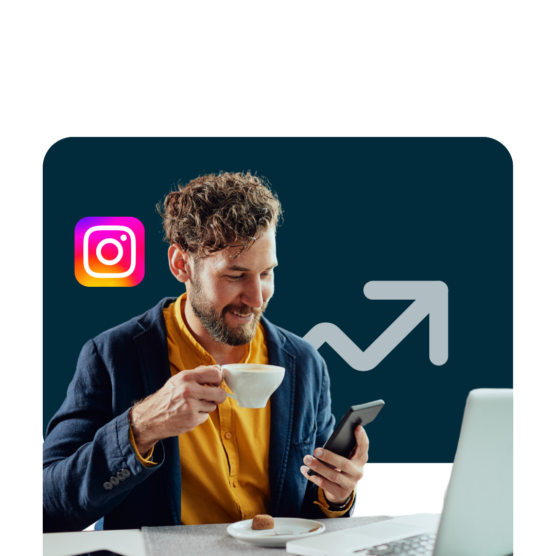Table of Contents
Trying to decide between organic vs. paid social media as a part of your strategy? We’ll let you in on a secret: you’re probably going to want to do a bit of both.
Paid and organic social media are two different beasts best harnessed for different goals. But for a holistic approach that balances awareness with conversion, it pays to know the pros and cons of each.
Let’s explore organic vs. paid social media, the benefits and drawbacks of each, and how you can choose the right strategy — or seamlessly combine the two for the best results.
Organic social media refers to the free or unpaid content (posts, photos, videos, memes, stories, etc.) that all users — people and brands alike — share with each other across social media.
Examples of organic social media activities include:
- Sharing regular, non-boosted content to your social media feeds
- Encouraging your team to share company content on their own feeds (employee advocacy)
- Engaging with your audience by responding to comments and direct messages in a timely and genuine manner
- Sharing user-generated content that your community has organically shared with their own followers
As a brand, when you post organically to your account, you can expect that the people who will see it are:
- A percentage of your followers (your “organic reach”)
- People who visit your social media profile
- Your followers’ followers (if people choose to share your post)
- People following any hashtags you use
- People the algorithm thinks your content will like (i.e., “suggested content”)
It sounds pretty simple, but the reason that organic social media is the foundation of every digital marketing strategy today is because it’s the best way to nurture a connection with your customers at scale.
For example, brands use organic social to:
- Generate awareness and conversation around their products or services
- Establish their personality and voice
- Build relationships by sharing informative, entertaining, and/or inspiring content
- Engage customers at every stage of their buying journey
- Support their customers with customer service
Here are a few examples of typical organic content.
First, we have an Instagram post where Asian Fusion restaurant CO shares a photo of a dinner dish perfect for the weather:
Below is an image Notion shared to its X/Twitter feed of stickers representing its three different products:
And here, we have another Instagram post from our own account sharing a carousel of graphics with different social media hooks to grab attention:
Each of these posts was shared organically to the brand’s feed so that people who land on your social media profile or are shown your post in their home feed are able to see it.
Organic social media is the cornerstone of a social media strategy. You simply can’t have a social media presence without it. Let’s cover a few of the main benefits that this type of social media can bring to your business.
It builds trust and authority with your audience
Organic social media builds trust. Why? Because no one wants to hop online just to be pummeled with endless advertisements.
Unlike paid campaigns, which are generally serving up an ask for a customer to complete, organic social media campaigns don’t need to drive sales. Instead, they focus on brand building, audience entertainment, and general updates.
As Peter Murphy Lewis, Fractional CMO at Strategic Pete, puts it, “Organic is where your voice, values, and vibe come through. It’s where your audience says, ‘I like how this brand thinks.’ It creates that layer of trust.”
Showing your audience you’re more than just a sales machine is essential to keeping them around long term. Sure, it’s fine to hit them with an ask from time to time, but if you completely axe your organic social media strategy altogether, you’ll soon be talking to an empty room.
It’s free!
Obviously one of the big, glaring benefits of organic social media is that it doesn’t cost you a thing. Anyone can create a social media account and start posting with no real upfront costs.
But more than that, organic content has staying power.
Like Brian Futral, Founder and Head of Content at The Marketing Heaven, says, “Organic social isn’t just cheap, it’s sticky. That’s the long game.”
He continues, “When audiences see a brand consistently showing up on their terms, with a real voice, and without an aggressive CTA, it builds something money can’t buy: emotional residue.”
Plus, while it might be easier to predict and measure results from paid social media campaigns, organic campaigns still have the potential to go viral and put your brand in front of audiences you could never imagine.
It’s a bit of a gamble, but it’s hard not to feel the draw of potential free engagement versus the expensive hope of a paid campaign.
It supports community engagement and loyalty
Organic social media helps you to build an engaged and loyal audience across your online presence.
Shanté Gorman, Founder at Sugarpunch Marketing, explains, “I’ve found that nothing beats organic social for building real connections with your audience. There’s something special about the trust and loyalty that develops when people engage with content that isn’t obviously promotional. In my experience, these authentic interactions create a community feeling that paid efforts just can’t replicate on their own.”
By creating organic content, sharing it to your feed, and engaging with your audience in the comments, you’re able to build a sustainable connection with your followers. This can turn them into loyal customers, something that your basic campaign simply can’t do in the same way.
But while there are obvious benefits to organic social media, there can also be some downsides, and it’s important to understand the pros and cons of every strategy you implement. Keep these drawbacks in mind so you know what to expect.
Slower to scale
Organic social media might be free, but it certainly takes its time to bring in results. When you’re first starting your social media profiles, it’s almost like you’ve brought your products or services to an empty market that no one bothered to promote. No one knows about your social media presence yet, but you still have to put in the work to show up.
Futral explains, “Organic social media takes forever to gain momentum. You can post five times a week, craft perfect captions, ride trends, even sprinkle memes, and still, reach crawls at a snails pace.”
Lewis echoes the sentiment, sharing, “Organic social media is compound interest — it takes time, consistency, and a clear POV.”
Organic content is a grind. It takes a lot of creation and a lot of engaging before you start to generate a bigger audience. But eventually, your growth becomes quicker and more exponential.
Limited reach due to algorithms
In addition, social media algorithms have been known to limit organic reach in favor of paid campaigns. After all, social media platforms are businesses in their own right, and are of course in the business of generating ad revenue.
Gorman doesn’t put it lightly. She says, “To be completely honest, fighting against the algorithm is exhausting. I can’t tell you how many times we’ve poured hours into creating what we thought was amazing content, only to have it barely seen because the platform decided not to show it.”
However — and we’ll cover this later — this is where paid can come to the aid of organic. If you put together an amazing piece of content that you think isn’t getting the attention it deserves, put some ad dollars behind it!
Paid social media refers to the sponsored or promoted content (ads, boosted posts, influencer campaigns, etc.) that brands put their advertising budget behind to push in front of more eyes.
Examples of paid social media activities include:
- Boosting posts to reach a larger audience than organic reach would allow
- Running targeted ad campaigns to reach specific audiences, demographics, or interests
- Promoting events, products, or services through sponsored posts
- Utilizing influencer partnerships to amplify reach through paid collaborations
A paid social media strategy allows businesses to increase visibility, drive traffic, and generate leads by investing in targeted advertising strategies on social media marketing platforms.
Businesses and organizations use social media advertising to:
- Boost brand awareness and attract a wider audience
- Promote their newest deal, content, event, etc.
- Generate leads
- Drive sales and conversions
Worldwide, social media ad spend is expected to reach $276.72 billion in 2025. This tells us that social media advertising is a huge market that’s not going anywhere. But it also lends to the idea that social media ads are a bit saturated, proving just why we need organic efforts tied in with our paid social media efforts. (But more on that later.)
Let’s look at a few great examples of paid social media content.
First, we have an Instagram ad from ecommerce company Estelle Colored Glass. This ad is promoting a couple of styles that the company won’t be making anymore, drumming up interest and creating a sense of urgency for people who want to be sure to grab those styles before they can’t anymore.
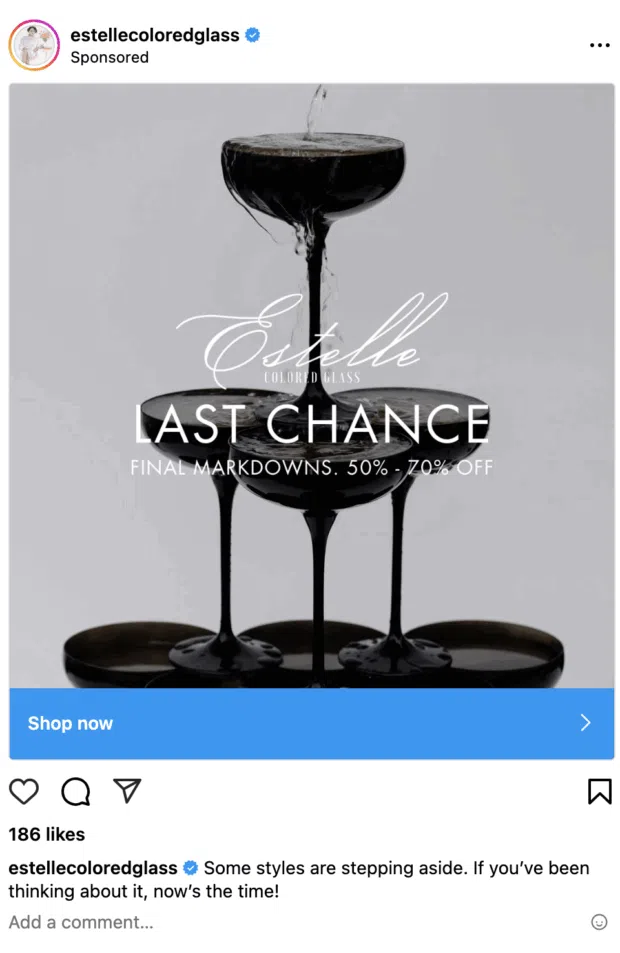
The next is a Facebook ad from clothing subscription brand Stitch Fix. The brand used a carousel ad format to showcase different outfits the viewer could create by starting up their subscription again, a great way to create intrigue and generate conversions.
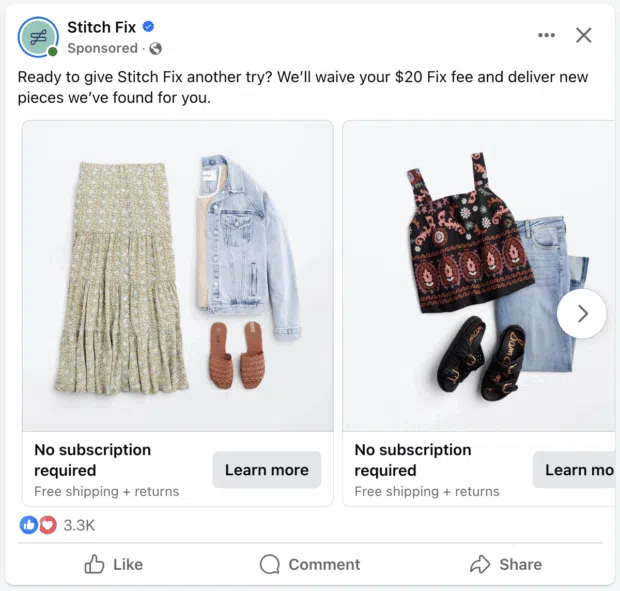
And finally, we have a Facebook ad from a form creation company sharing tips for creating successful forms. This ad is meant to generate clicks and traffic to the company’s website, leading users to a blog post with even more lead generation tips.
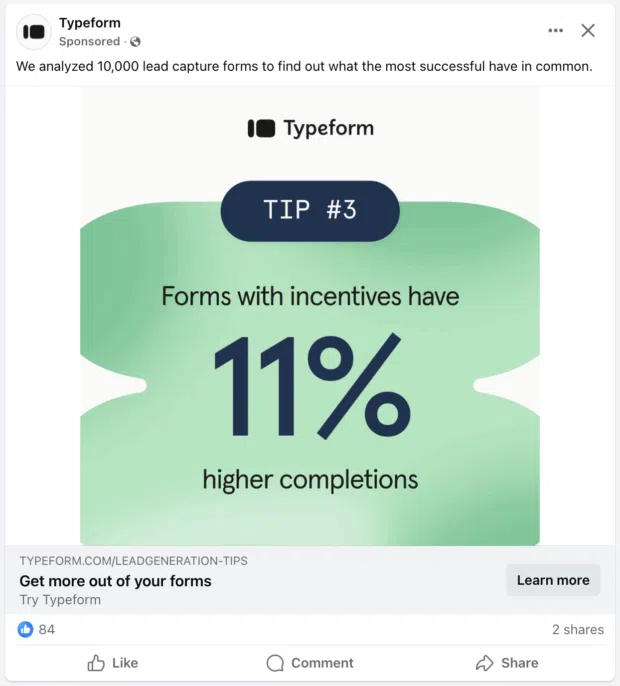
Each of these ads serves its own purpose, aligning with the company’s business goals — whether those are to generate awareness and traffic or to generate revenue.
Paid campaigns come with clearcut benefits even though you have to put some of your budget behind them to get started. Let’s go through some of these benefits to showcase why you should be including paid social media within your strategy.
It allows advanced targeting
Marketing has come a long way since the digital revolution.
While, in the past, getting your brand in front of customers meant purchasing TV spots, billboards, or print ads — with no real way of knowing if people saw them and purchased from you because of it — today, digital marketing (and social media marketing) allow for granular, precise targeting options on a global level.
What does this mean?
Well, let’s say you’re advertising a new breakfast cereal in America. You know your target audience is working mothers between the ages of 25 and 45. You know that, those who live in the suburbs need different messaging than those living in the city (morning commutes make easy breakfasts appealing, while multi-family homes prefer to hear about value for investment).
Now, if you were to advertise your product on television, you’re not going to be able to talk to that audience directly. Sure, you can pay to have your ad run at a time when you think they are most likely to be in front of the TV, but apart from that, there’s no real way to tell if they saw it or not.
By comparison, running that same ad on Facebook, Instagram, YouTube, TikTok, etc., lets you target those specific demographics.
You can choose to show your paid ads to people in a specific age bracket, location, and even niche down further to target specific behavior types (shops at a grocery that sells your product, for example). You can also run retargeting ads that put your business in front of potential customers who are already considering buying your product.
Gorman agrees, saying, “The targeting capabilities of paid social are honestly why we use it so much. I love being able to get super specific about who sees my client’s content.”
“For example, we could reach 35-year-old dog owners in Seattle who like camping and have recently bought outdoor gear. This level of precision helps ensure you’re not wasting resources on people who aren’t interested in what you offer.”
What’s more, with paid social media advertising, you can create lookalike audiences that are similar to the customers you already know about — which is an easy way to expand your audience even further.
It has clear ROI
As explained above, traditional advertising was long plagued by a lack of detailed targeting and data to calculate return on investment (ROI).
Sure, you could draw a correlation between your recent TV ad spending and an uptick in sales, but it was hard to discern exactly what was moving the needle.
Social media advertising is the opposite. Performance for individual ads is constantly tracked and recorded, showing you exactly how much you paid for every click, sale, and lead.
From there, all you need to do is choose the social media platform that gives you the best returns, and slowly improve and optimize your ads based on the data you collect.
It’s easy to track
You might be thinking, sure, I have all of this data on hand, but how can I collect and record it? Luckily, you don’t have to be an Excel expert or spreadsheet superstar to make use of your paid social media data.
All social media platforms come complete with basic ads tracking and analytics. Facebook and Instagram have the Meta Business Suite, X/Twitter has X Ads and Analytics, LinkedIn has LinkedIn Ads and Analytics, and TikTok has TikTok Ads Manager and Analytics.
If you want to take your data even further, third-party tools like Hootsuite Analytics let you track your paid social media efforts across platforms, and manage all of your data from within a single dashboard.
Plus, access detailed reporting features to learn how to improve them on the fly.
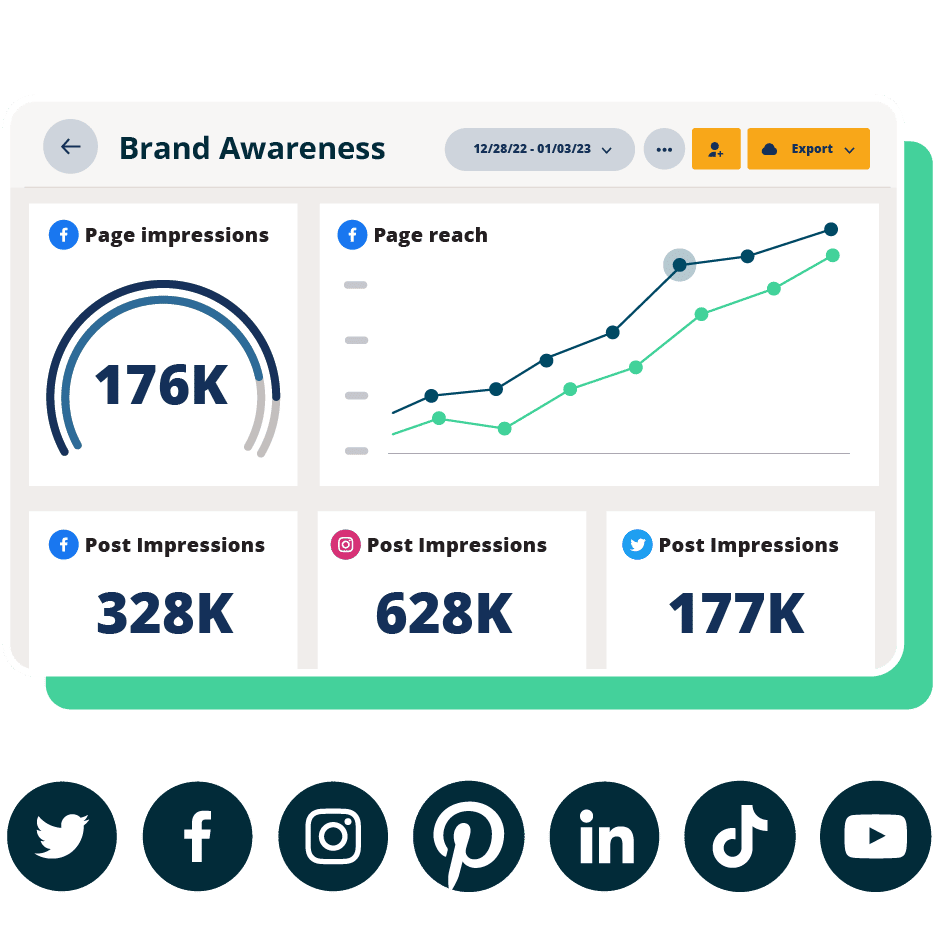
Beautiful reports. Clear data. Actionable insights to help you grow faster.
Start free 30-day trialNow let’s talk about a few cons that paid social media can bring to the table. It’s important to keep these in mind to understand how to create a well-rounded strategy that appeals to your audience and doesn’t cost too much.
Can be expensive, quickly
We mention cost because paid social media has the potential to get expensive — and quickly. To keep costs down, you need to be strategic about your ad spend and consistently monitor your ad performance so you’re not overspending.
Requires continuous optimization
Part of keeping ad costs down is continuously checking in and optimizing your ads, but it’s also one of the major drawbacks of this strategy. Paid ads are not a set it and forget it strategy.
Instead, businesses often need a dedicated team member whose sole responsibility is creating, optimizing, and analyzing paid ad campaigns. This is yet another expense that paid social media can cost your business.
Ad fatigue
Another major drawback is ad fatigue, or the idea that people are advertised to so often that they simply don’t even notice or pay attention anymore.
As Gorman puts it, “I’ve noticed that as soon as people get a whiff that something is an ad, they tune out immediately. The dreaded ‘sponsored’ label can be a kiss of death for engagement.”
“People have become so good at spotting and ignoring ads that breaking through that mental filter is tougher than ever.”
So what do you do? Well, you aim to put together an ad campaign that simply can’t be ignored or that is so good people see it even past that “sponsored” label.
Now let’s look at these two social media marketing strategies side-by-side. You’ll notice that while there are key differences throughout, the two very obviously balance each other out.
| Organic social media marketing | Paid social media marketing | |
|---|---|---|
| Reach | Limited to followers and organic reach | Potentially unlimited reach with targeting and ad budget |
| Engagement | Typically lower due to algorithms and competition | Higher potential for engagement with promoted content |
| Returns | Often indirect or difficult to measure | Directly measurable through analytics and ROI tracking |
| Brand | Builds brand reputation over time through organic content | Can boost brand visibility and awareness through social media ads |
| Attribution | Difficult to attribute specific actions to social efforts | Clear attribution through ad platform analytics |
| Targeting | Limited to demographics and interests of organic audience | Precise targeting based on demographics, behavior, interests |
| Relationship building | Fosters genuine connections with audience | Can reach new audiences and nurture existing relationships |
| Resources | Requires consistent time and effort to create content | Requires budget for ad spend and potentially agency fees |
| Content | More authentic, less promotional | Often more polished and tailored to specific objectives, but is also very promotional in nature |
Do you see what we mean about balance?
An organic social media strategy nurtures your relationship with your customers or audience. It helps you:
- Establish and grow your brand’s presence where people are already spending their time
- Support and retain existing customers
- Convert new customers by showing them what you’re about
However, organic marketing efforts are often slower to reach business goals. And while this strategy is technically free, it takes a lot of time, experimentation and/or experience to get right.
Meanwhile, a paid social media strategy is how you connect with new customers or audience members. It helps you:
- Reach a larger number of people
- Target your ideal customer more precisely
- Hit your business goals faster
That said, it requires a budget and its own form of expertise (those ads don’t monitor themselves).
In short, while organic activity is necessary for relationship-building, it’s also true that social network ranking algorithms mean pay-to-play is a fact of life in the marketing world—at least for now.
Organic and paid social media marketing have major differences — but those differences make for a perfect hybrid strategy. Use these tips to create the perfect social media strategy for your business.
1. Boost your top organic posts
Your top-performing posts aren’t just here to puff up your vanity metrics. Probably the easiest way to dip your toes into the pool of paid advertising is to identify content that has really resonated with your audience and pay to show it to new eyes.
This is generally considered an entry-level tactic because it’s low-risk — you don’t need to come up with an ad, let alone an ad campaign. But most social media pros will tell you that when they notice they’ve got a hit on their hands, it’s time to consider supporting it with spend.
Gorman explains, “My favorite approach is taking organic posts that already performed well and putting some ad spend behind them.”
“It’s like getting the best of both worlds — content that feels natural and authentic to the platform but with the targeting muscle of paid promotion. I’ve seen dramatically better results with this method than with content created specifically as ads.”
With this tactic, you could start by allocating a small budget to the top weekly or monthly post whenever you run your analytics report. Don’t just pay attention to likes, but also conversions, profile views, etc.
Pro Tip: With Hootsuite’s Boost tool you can customize triggers to automatically boost posts that are snowballing (for example, whenever your post gets shared 100 times).
2. Use organic insights to inform paid targeting
In a similar vein, you can look at top-performing topics or post types that are lending to your organic growth, then incorporate some of those topics into your paid ads strategy.
Lewis tells us, “We always test content themes on LinkedIn or Instagram Reels first. If a post gets traction organically, it becomes the blueprint for our paid campaigns.”
For example, if you test a new type of content as a part of your social media content strategy — like using photos instead of graphics created by a designer — and it performs well organically, you can start to incorporate some of those same assets into your paid ads.
Kris Flank, CEO of LunarLinks, agrees, saying you make the most out of your paid and organic strategies by combining them.
She explains, “Utilize paid to enhance what’s already building momentum organically. What you won’t be doing is speculating — you’ll be investing in content that people have already indicated that they’ll be interested in.”
3. Run A/B tests
We say it all the time, but in our experience, A/B testing is a step that’s skipped way too often.
Before you allocate your entire social media budget to an ad, run versions of it by a smaller audience to see if it’s any good. Test your CTA, copywriting, visuals, and the ad’s placement, format, and even the audience targeting.
You can also test it among different audience demographics (age, location, etc.) before you commit to a larger spend. The benefit here is twofold: a more memorable, enjoyable and successful ad for your audience is also a cheaper one for you.
Meanwhile, for organic posts, you can set up manual split tests and track results by using UTM parameters in your links. Our complete guide to A/B testing on social media is over here.
4. Create a full-scale strategy
Organic and paid social media have different purposes. While your organic content can easily inform some of your paid strategies, at the end of the day, the two should be used with different goals in mind.
As Jason Pack, CRO at Freedom Debt Relief, puts it, “Paid and organic work best hand-in-hand. You should run ads to drive sales and use organic content to build trust, engagement, and long-term loyalty.”
Your organic social media efforts help show off your brand’s personality, build relationships with customers, and put high-quality, valuable content in front of your audience.
Your paid social media efforts make an impact to your bottom line by driving clicks, sales, leads, and conversions.
When your organic and paid strategies operate separately, it’s tough to get a complete picture of what’s working and what’s not. That’s where Hootsuite comes in.
With Hootsuite, you can seamlessly manage all your paid content alongside your organic posts, allowing you to move quickly and capitalize on new opportunities before they slip away.
Here’s how Hootsuite can help you streamline your social media management:
A single advertising dashboard
Gone are the days of switching between multiple platforms to manage your advertising campaigns. With Hootsuite’s intuitive interface, you can publish, manage, analyze, boost, and report on ads — all from a single, user-friendly dashboard.
Streamline your workflow and save time by eliminating the need to navigate between different tabs or tools. Hootsuite brings all your advertising tools together in one convenient location, allowing you to focus on crafting compelling content and driving results.

Build and post ads for Facebook, Instagram, LinkedIn, and X. Our targeting and reporting are seriously easy.
Start free 30-day trialCross-channel publishing and planning
Say goodbye to toggling between different platforms to create and launch content. With Hootsuite Composer, you can streamline the process by crafting and scheduling your posts — organic and paid — for LinkedIn, Facebook, and Instagram at the same time.
Whether you’re targeting new customers or promoting a specific campaign, Hootsuite’s Composer makes it easy to create content that resonates with your specific audience.
Hyper-targeted organic boosting
With organic reach on the decline, boosting posts has become a key strategy for expanding your content’s reach on social media.
When you boost a post, you extend its reach beyond your followers, reaching a wider audience. You have the flexibility to choose your campaign goal, target audience based on demographics, location, and interests, set your budget, and determine the duration of the promotion.
With Hootsuite’s boosting feature, you can optimize your ad spend by targeting the right audience based on geographic and personal characteristics. Tailor your promotions to specific demographics, interests, and locations to ensure your content resonates with the right people.
Boosting is available for both Facebook, Instagram, and LinkedIn, allowing you to extend the reach of your posts to new audiences.
Side-by-side analytics and reporting
Analytics is where the magic happens. Hootsuite allows you to review both organic and paid content side by side, giving you valuable insights into what’s working and what’s not.
By filtering campaign metrics and pulling data from your organic content, you can optimize your paid strategy and vice versa.
Plus, with the ability to create in-depth reports and schedule automated email delivery, Hootsuite takes the hassle out of reporting and allows you to focus on strategy.
Which is better: organic or paid social media?
With organic and paid social media, there’s not really a “which is better” answer. They both do different things and they both have different goals.
However, if you can only focus on one, we’d have to say you need to work more on your organic efforts. A paid strategy without any organic content to back it up is going to look suspicious to your audience. It’s better to grow slowly, but surely, with organic tactics.
Can you do both organic and paid social?
Yes! In fact, it’s highly encouraged. Having a full-scale strategy that incorporates both organic and paid tactics is the best way to reach your audience and keep them engaged.
What’s the ROI of organic vs paid social?
ROI is measured in different ways with organic versus paid strategies. With paid social media, you can easily measure how much you’re spending versus how much you’re bringing in. With organic social media, you need to look more at what the value of new followers, social media interactions, and reach means to your business.
Is organic social media really free?
Yes and no. In a strictly monetary sense, you do not have to pay social media platforms anything to post social media content organically.
However, you do have to consider things like:
The costs associated with team members you hire to create and engage on social media
The time it takes to grow organically
The costs associated with software and tools needed to create quality content
How do I know if my paid social media is working?
With paid social media ads, you can look at KPIs like click-through rates, cost per conversion, and cost per impression to see if your ads are performing at the level you want them to. If you’re happy with the amount you’re paying, then your paid social media is working!
When should I start using paid social media?
You can start using paid social media tactics at any point in your social media strategy.
However, we recommend having at least one organic social media post on any platform you use to create ads so that people have something to see if they click through to your profile.
Integrate your paid and organic social strategies to strengthen connections with existing customers and reach new ones. Use Hootsuite Social Advertising to easily keep track of all of your social media activity—including ad campaigns—and get a complete view of your social ROI. Try it free today.






